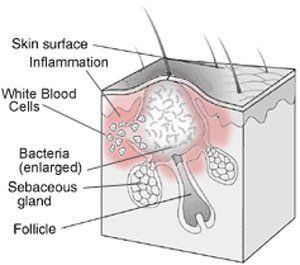Causes // Types
What is Acne?
Acne is the #1 skin disease in the United States. Acne has genetic, hormonal, and infectious factors that make it difficult to treat and predict its prognosis, but when diagnosed early, can easily be treated.
Causes // Types
What is Acne?
Acne is the #1 skin disease in the United States. Acne has genetic, hormonal, and infectious factors that make it difficult to treat & predict its prognosis, but when diagnosed early, can easily be treated.
Causes // Types
What is Acne?
Acne is the #1 skin disease in the United States. Acne has genetic, hormonal, and infectious factors that make it difficult to treat and predict its prognosis, but when diagnosed early, can easily be treated.
Causes of Acne
Simply put, acne is a result of an overproduction of skin cells, which clog up hair follicles and sebaceous (oil) glands. These glands normally produce oil that drains through the follicles up to the skin. Once blocked, it’s the perfect home for Propionibacterium acnes, allowing these bacteria to grow, proliferate, and cause acne!
Causes of Acne
Simply put, acne is a result of an overproduction of skin cells, which clog up hair follicles and sebaceous (oil) glands. These glands normally produce oil that drains through the follicles up to the skin. Once blocked, it’s the perfect home for Propionibacterium acnes, allowing these bacteria to grow, proliferate, and cause acne!
Why You Might Have Acne
Why You Might Have Acne
Hormonal
Acne begins at puberty with a spike in Testosterone, regardless of sex. This hormone makes the follicles grow larger, increase in sebum production, leading to more clogged pores.
Infectious
Propionibacterium acnes is an anaerobic bacteria that loves to live in oil. Once your pores are clogged, this bacteria thrives and becomes the major culprit in causing progression of acne.
Genetic
Acne tends to run in the family. Therefore, a family history of acne usually results in early onset of acne in children.
Hormonal
Acne begins at puberty with a spike in Testosterone, regardless of sex. This hormone makes the follicles grow larger, increase in sebum production, leading to more clogged pores.
Infectious
Propionibacterium acnes is an anaerobic bacteria that loves to live in oil. Once your pores are clogged, this bacteria thrives and becomes the major culprit in causing progression of acne.
Genetic
Acne tends to run in the family. Therefore, a family history of acne usually results in early onset of acne in children.
Two Major Types of Acne:
Non-Inflammatory: The follicular wall is intact.- White Heads: Tiny white spots caused by trapped sebum (oil) and bacteria. Usually, invisible to the naked eye, but feel rough to the touch.
- Black Heads: Occur when the pore opens to the surface, sebum is released to the skin, which contains the skin pigment melanin, oxidizes and turns black/brown color. This is not dirt, which can easily be washed away.
Inflammatory: Follicular wall has ruptured! This leads to redness, pimple popping, and ultimately scarring!- Papule: This is the early stages of inflammatory acne, when white blood cells rush in to the injured follicle.
- Pustule: “The Zit”- This occurs several days after when the white blood cells make their way to the surface of the skin.
- White Heads: Tiny white spots caused by trapped sebum (oil) and bacteria. Usually, invisible to the naked eye, but feel rough to the touch.
- Black Heads: Occur when the pore opens to the surface, sebum is released to the skin, which contains the skin pigment melanin, oxidizes and turns black/brown color. This is not dirt, which can easily be washed away.
Inflammatory: Follicular wall has ruptured! This leads to redness, pimple popping, and ultimately scarring!
- Papule: This is the early stages of inflammatory acne, when white blood cells rush in to the injured follicle.
- Pustule: “The Zit”- This occurs several days after when the white blood cells make their way to the surface of the skin.


Two Major Types of Acne:
Non-Inflammatory: The follicular wall is intact.- White Heads: Tiny white spots caused by trapped sebum (oil) and bacteria. Usually, invisible to the naked eye, but feel rough to the touch.
- Black Heads: Occur when the pore opens to the surface, sebum is released to the skin, which contains the skin pigment melanin, oxidizes and turns black/brown color. This is not dirt, which can easily be washed away.
Inflammatory: Follicular wall has ruptured! This leads to redness, pimple popping, and ultimately scarring!- Papule: This is the early stages of inflammatory acne, when white blood cells rush in to the injured follicle.
- Pustule: “The Zit”-This occurs several days after when the white blood cells make their way to the surface of the skin.
- White Heads: Tiny white spots caused by trapped sebum (oil) and bacteria. Usually, invisible to the naked eye, but feel rough to the touch.
- Black Heads: Occur when the pore opens to the surface, sebum is released to the skin, which contains the skin pigment melanin, oxidizes and turns black/brown color. This is not dirt, which can easily be washed away.
Inflammatory: Follicular wall has ruptured! This leads to redness, pimple popping, and ultimately scarring!
- Papule: This is the early stages of inflammatory acne, when white blood cells rush in to the injured follicle.
- Pustule: “The Zit”-This occurs several days after when the white blood cells make their way to the surface of the skin.

MediTouch® products for my face have helped even out my skin tone and replenish a glow that I have not seen in quite a while. I have referred friends and family for their skin care needs and will always continue to do so!
Jessica Bueno
Button
I've been using the MediTouch® products for 8 months and can't imagine using anything else!
Wendy Mendes
Button
I have been using MediTouch® Clinical Skin Care products for about 3 months and the results are amazing! The products are easy and quick to use. They showed me how to use them and selected products that were best for my skin type. I plan to continue to use the products!
Laura VanDyke
Button

MediTouch® products for my face have helped even out my skin tone and replenish a glow that I have not seen in quite a while. I have referred friends and family for their skin care needs and will always continue to do so!
Jessica Bueno
Button
I've been using the MediTouch® products for 8 months and can't imagine using anything else!
Wendy Mendes
Button
I have been using MediTouch® Clinical Skin Care products for about 3 months and the results are amazing! The products are easy and quick to use. They showed me how to use them and selected products that were best for my skin type. I plan to continue to use the products!
Laura VanDyke
Button
Personalized Skin Consultation
Send close-up images using the form below to receive your customized product recommendations from our skin care specialists:
Contact Us
Thank you for sending your photo to us!
Oops, there was an error sending your message.
Please try again later
Please try again later
Contact Us
Thank you for sending your photo to us!
Oops, there was an error sending your message.
Please try again later
Please try again later

